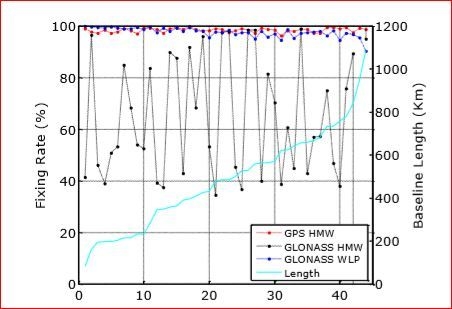Improved Method for GLONASS Long Baseline Ambiguity Resolution without Inter-Frequency Code Bias Calibration
Abstract
:1. Introduction
2. Method
2.1. SDBR Baseline Processing Model
2.2. Traditional Ambiguity Fixing Procedure
2.3. Improved Ambiguity Fixing Procedure
3. Data and Processing Strategy
4. Results
4.1. Deficiency of the Traditional Method
4.2. Efficiency of the Improved Method
5. Discussion
6. Conclusions
Author Contributions
Funding
Conflicts of Interest
References
- Soler, T.; Michalak, P.; Weston, N.; Snay, R.; Foote, R. Accuracy of OPUS solutions for 1- to 4-h observing sessions. GPS Solut. 2006, 10, 45–55. [Google Scholar] [CrossRef]
- Blewitt, G. Carrier phase ambiguity resolution for the global positioning system applied to geodetic baselines up to 2000 km. J. Geophys. Res. 1989, 94, 10187–10203. [Google Scholar] [CrossRef]
- Árnadóttir, T.; Jiang, W.; Feigl, K.L.; Geirsson, H.; Sturkell, E. Kinematic models of plate boundary deformation in southwest Iceland derived from GPS observations. J. Geophys. Res. 2006, 111. [Google Scholar] [CrossRef] [Green Version]
- Haase, J.; Ge, M.; Vedel, H.; Calais, E. Accuracy and variability of GPS tropospheric delay measurements of water vapor in the western mediterranean. J. Appl. Meteorol. 2003, 42, 1547–1568. [Google Scholar] [CrossRef]
- Pacione, R.; Vespe, F. Comparative studies for the assessment of the quality of near-real-time GPS-derived atmospheric parameters. J. Atmos. Ocean. Technol. 2008, 25, 701–714. [Google Scholar] [CrossRef]
- Dach, R.; Lutz, S.; Walser, P.; Fridez, P. Bernese GNSS Software Version 5.2. User Manual; Astronomical Institute, Universtiy of Bern, Bern Open Publishing: Bern, Switzerland, 2015; ISBN 978-3-906813-05-9. [Google Scholar] [CrossRef]
- Herring, T.; King, R.; McClusky, S. GAMIT Reference Manual: GPS Analysis at MIT; Release 10.4; Department of Earth, Atmospheric, and Planetary Sciences, Massachusset Institute of Technology: Cambridge, MA, USA, 2010. [Google Scholar]
- Shi, C.; Zhao, Q.; Lou, Y. Recent development of PANDA software in GNSS data processing. Proc. SPIE 2008, 7285, 231–249. [Google Scholar]
- Dow, J.; Neilan, R.; Rizos, C. The international GNSS service in a changing landscape of global navigation satellite systems. J. Geod. 2009, 83, 191–198. [Google Scholar] [CrossRef]
- Dilssner, F.; Springer, T.; Gienger, G.; Dow, J. The GLONASS-M satellite yaw-attitude model. Adv. Space Res. 2010, 47, 160–171. [Google Scholar] [CrossRef]
- Raby, P.; Daly, P. Using the GLONASS system for geodetic surveys. In Proceedings of the 6th International Technical Meeting of the Satellite Division of the Institute of Navigation, Salt Lake City, UT, USA, 22–24 September 1993; pp. 1129–1138. [Google Scholar]
- Pratt, M.; Burke, B.; Misra, P. Single-epoch integer ambiguity resolution with GPS-GLONASS L1-L2 Data. In Proceedings of the ION GPS-98, Nashville Convention Center, TN, USA, 15–18 September 1998; pp. 691–699. [Google Scholar]
- Leick, A. GLONASS satellite surveying. J. Surv. Eng. 1998, 124, 91–99. [Google Scholar] [CrossRef]
- Dai, L.; Han, S.; Rizos, C. A new data processing strategy for combined GPS/GLONASS carrier phase-based positioning. In Proceedings of the 12th International Technical Meeting of the Satellite Division of the U.S. Institution of Navigation, Nashville, TN, USA, 14–17 September 1999; pp. 1619–1627. [Google Scholar]
- Wang, J.; Leick, A.; Rizos, C.; Stewart, M. GPS and GLONASS integration: Modeling and ambiguity resolution issues. GPS Solut. 2001, 5, 55–64. [Google Scholar] [CrossRef]
- Leick, A. GPS Satellite Surveying; Wiley: New York, NY, USA, 1995; p. 560. [Google Scholar]
- Landau, H.; Vollath, U. Carrier phase ambiguity resolution using GPS and GLONASS signals. In Proceedings of the 9th International Technical Meeting of the Satellite Division of the U.S. Institution of Navigation GPS ION’96, Kansas City, MO, USA, 17–20 September 1996; pp. 917–923. [Google Scholar]
- Takasu, T.; Yasuda, A. Development of the low-cost RTK-GPS receiver with an open source program package RTKLIB. In Proceedings of the International Symposium on GPS/GNSS, Seogwipo-si Jungmun-dong, Korea, 4–6 November 2009. [Google Scholar]
- Al-Shaery, A.; Zhang, S.; Rizos, C. An enhanced calibration method of GLONASS inter-channel bias for GNSS RTK. GPS Solut. 2013, 17, 165–173. [Google Scholar] [CrossRef]
- Povalyaev, A. Using single differences for relative positioning in GLONASS. In Proceedings of the 10th International Technical Meeting of the Satellite Division of the U.S. Institution of Navigation, Kansas, MO, USA, 16–19 September 1997; pp. 929–934. [Google Scholar]
- Cao, W.; O’Keefe, K.; Cannon, M. Performance Evaluation of GPS/Galileo Multiple-frequency RTK Positioning Using a Single-difference Processor. In Proceedings of the ION GNSS 2008, Savannah, GA, USA, 16–19 September 2008; pp. 2841–2849. [Google Scholar]
- Feng, Y.; Li, B. Four Dimensional Real Time Kinematic State Estimation and Analysis of Relative Clock Solutions. In Proceedings of the ION GNSS 2010, Portland, OR, USA, 21–24 September 2010; pp. 2092–2099. [Google Scholar]
- Liu, Y.; Ye, S.; Jiang, P.; Song, W.; Lou, Y. Combining GPS+GLONASS observations to improve the fixing percentage and precision of long baselines with limited data. Adv. Space Res. 2016, 57, 1258–1267. [Google Scholar] [CrossRef]
- Wanninger, L.; Wallstab-Freitag, S. Combined GPS, GLONASS, and SBAS code phase and carrier phase measurements. In Proceedings of the 20th International Technical Meeting of the Satellite Division of the U.S. Institution of Navigation, Fort Worth, TX, USA, 25–28 September 2007; pp. 866–875. [Google Scholar]
- Sleewaegen, J.; Simsky, A.; de Wilde, W.; Boon, F.; Willems, T. Demystifying GLONASS inter-frequency carrier phase biases. InsideGNSS 2012, 7, 57–61. [Google Scholar]
- Wanninger, L. Carrier phase inter-frequency biases of GLONASS receivers. J. Geod. 2012, 86, 139–148. [Google Scholar] [CrossRef]
- Kozlov, D.; Tkachenko, M.; Tochilin, A. Statistical characterisation of hardware biases in GPS+GLONASS receivers. In Proceedings of the 13th International Technical Meeting of the Satellite Division of the U.S. Institution of Navigation, Salt Lake City, UT, USA, 19–22 September 2000; pp. 817–826. [Google Scholar]
- Yamada, H.; Takasu, T.; Kubo, N.; Yasuda, A. Evaluation and calibration of receiver inter-channel biases for RTK-GPS/GLONASS. In Proceedings of the ION GNSS-2010, Portland, OR, USA, 21–24 September 2010; pp. 1580–1587. [Google Scholar]
- Reussner, N.; Wanninger, L. GLONASS Inter-frequency Biases and Their Effects on RTK and PPP Carrier phase Ambiguity Resolution. In Proceedings of the ION GNSS 2011, Institute of Navigation, Portland, OR, USA, 19–23 September 2011; pp. 712–716. [Google Scholar]
- Banville, S.; Collins, P.; Lahaye, F. Concepts for undifferenced GLONASS ambiguity resolution. In Proceedings of the 26th International Technical Meeting of the Satellite Division of The Institute of Navigation (ION GNSS+ 2013), Nashville, TN, USA, 16–20 September 2013; pp. 1186–1197. [Google Scholar]
- Chuang, S.; Yi, W.; Song, W.; Lou, Y.; Zhang, R. GLONASS pseudorange inter-channel biases and their effects on combined GPS/GLONASS precise point positioning. GPS Solut. 2013, 17, 439–451. [Google Scholar] [CrossRef]
- Hatch, R. The synergism of GPS code and carrier measurements. In Proceedings of the Third International Symposium on Satellite Doppler Positioning at Physical Sciences Laboratory of New Mexico State University, Las Cruces, NM, USA, 8–12 February 1982; Volume 2, pp. 1213–1231. [Google Scholar]
- Melbourne, W. The case for ranging in GPS-based geodetic systems. In Proceedings of the First International Symposium on Precise Positioning with the Global Positioning System, Rockville, MD, USA, 15–19 April 1985. [Google Scholar]
- Wübbena, G. Software developments for geodetic positioning with GPS using TI-4100 code and carrier measurements. In Proceedings of the First International Symposium on Precise Positioning with the Global Positioning System, Rockville, MD, USA, 5–19 April 1985. [Google Scholar]
- Yi, W. Research on Rapid Convergence and Integer Ambiguity Resolution Method for Multi-GNSS Precise Point Positioning. Ph.D. Thesis, Wuhan University, Wuhan, China, 2015. (In Chinese). [Google Scholar]
- Banville, S. GLONASS ionosphere-free ambiguity resolution for precise point positioning. J. Geod. 2016, 90, 487–496. [Google Scholar] [CrossRef]
- Liu, Y.; Ge, M.; Shi, C.; Lou, Y.; Wickert, J.; Schuh, H. Improving integer ambiguity resolution for GLONASS precise orbit determination. J. Geod. 2016, 90, 715–726. [Google Scholar] [CrossRef]
- Geng, J.; Zhao, Q.; Shi, C.; Liu, J. A review on the inter-frequency biases of GLONASS carrier-phase data. J. Geod. 2016, 91, 329–340. [Google Scholar] [CrossRef]
- Geng, J.; Bock, Y. GLONASS fractional-cycle bias estimation across inhomogeneous receivers for PPP ambiguity resolution. J. Geod. 2015. [Google Scholar] [CrossRef]
- Yi, W.; Song, W.; Lou, Y.; Shi, C.; Yao, Y. A method of undifferenced ambiguity resolution for GPS+GLONASS precise point positioning. Sci. Rep. 2016, 6, 26334. [Google Scholar] [CrossRef] [PubMed] [Green Version]
- Liu, Y.; Gu, S.; Li, Q. Calibration of glonass inter-frequency code bias for PPP ambiguity resolution with heterogeneous rover receivers. Remote Sens. 2018, 10, 399. [Google Scholar] [CrossRef]
- Liu, Y.; Song, W.; Lou, Y.; Ye, S.; Zhang, R. Glonass phase bias estimation and its PPP ambiguity resolution using homogeneous receivers. GPS Solut. 2016. [CrossRef]
- Liu, Y.; Ye, S.; Song, W.; Lou, Y.; Gu, S.; Li, Q. Rapid PPP Ambiguity Resolution Using GPS+GLONASS Observations. J. Geod. 2016. [Google Scholar] [CrossRef]
- Hernández-Pajares, M.; Juan, J.; Sanz, J.; Orús, R.; Garcia-Rigo, A.; Feltens, J.; Komjathy, A.; Schaer, S.; Krankowski, A. The IGS VTEC maps: A reliable source of ionospheric information since 1998. J. Geod. 2009, 83, 263–275. [Google Scholar] [CrossRef]
- Boehm, J.; Niell, A.; Tregoning, P.; Schuh, H. Global mapping function (GMF): A new empirical mapping function based on numerical weather model data. Geophys. Res. Lett. 2006, 33, L07304. [Google Scholar] [CrossRef]
- Gao, W.; Gao, C.; Pan, S.; Meng, X.; Xia, Y. Inter-system differencing between GPS and BDS for medium-baseline RTK positioning. Remote Sens. 2017, 9, 948. [Google Scholar] [CrossRef]
- Li, G.; Geng, J.; Guo, J.; Zhou, S.; Lin, S. GPS + Galileo tightly combined RTK positioning for medium-to-long baselines based on partial ambiguity resolution. J. Glob. Position. Syst. 2018, 16, 3. [Google Scholar] [CrossRef]
- Yalvac, S.; Berber, M. Galileo satellite data contribution to GNSS solutions for short and long baselines. Measurement 2018, 124, 173–178. [Google Scholar] [CrossRef]
- Paziewski, J.; Sieradzki, R.; Wielgosz, P. On the Applicability of Galileo FOC Satellites with Incorrect Highly Eccentric Orbits: An Evaluation of Instantaneous Medium-Range Positioning. Remote Sens. 2018, 10, 208. [Google Scholar] [CrossRef]



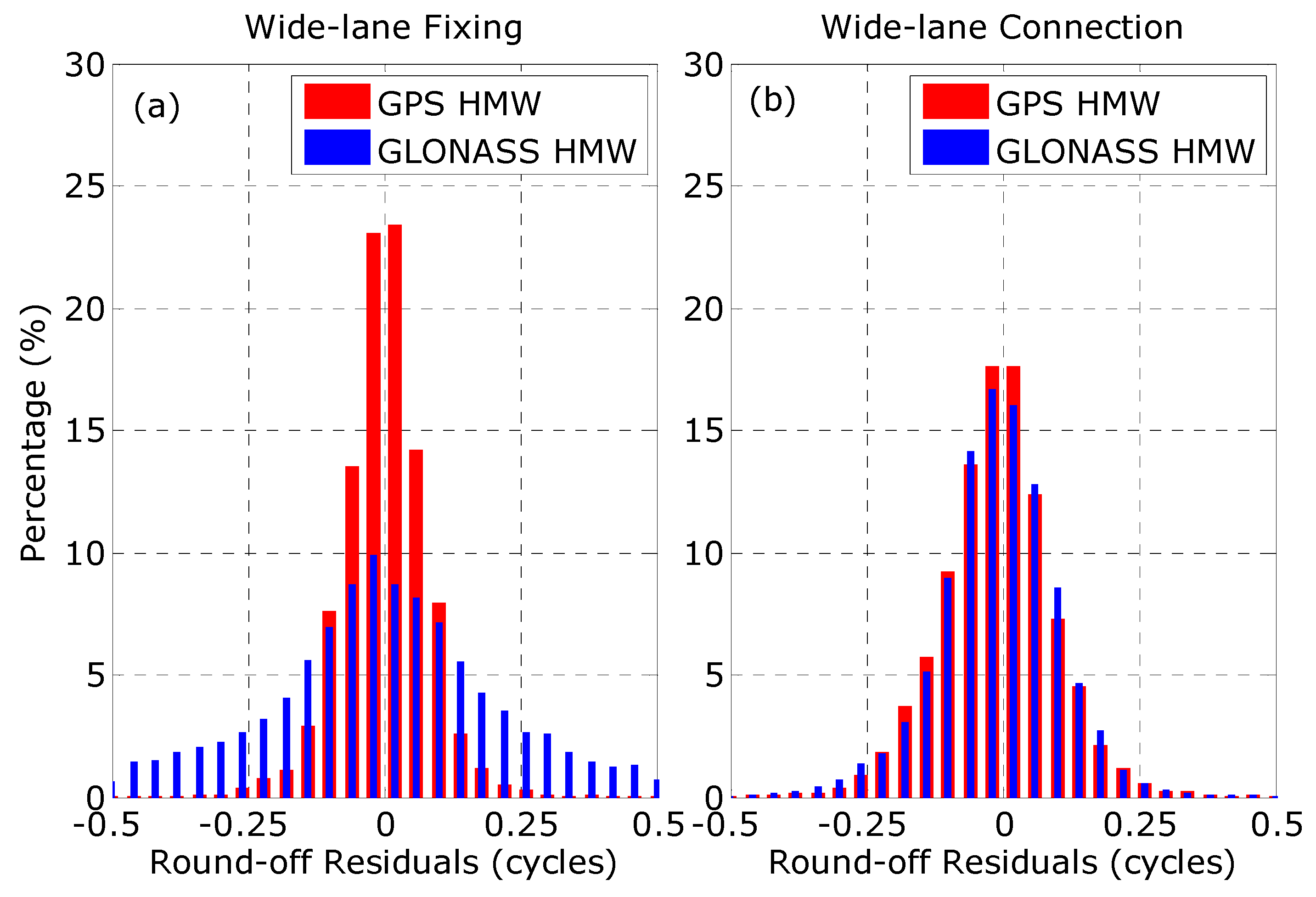
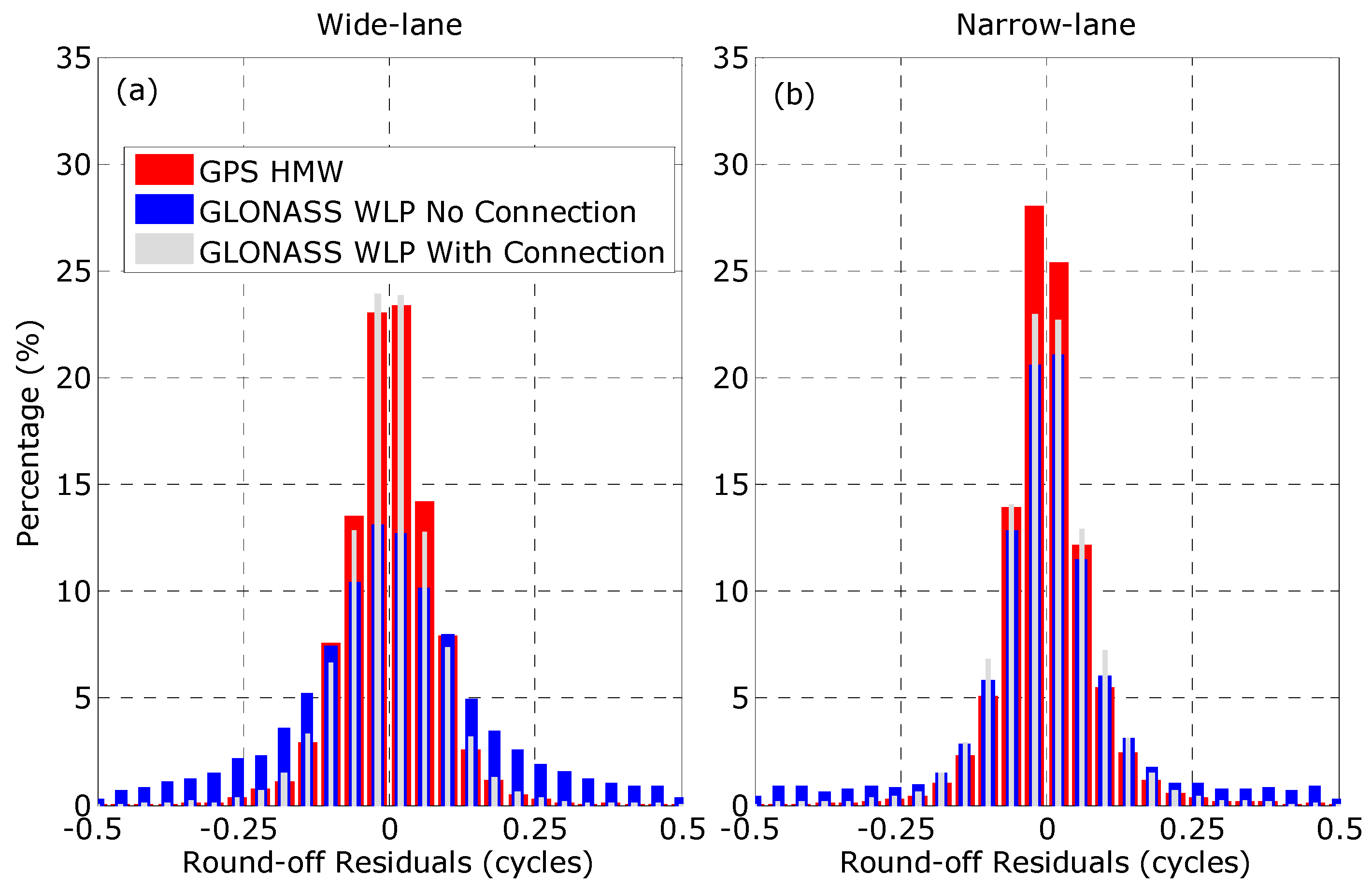
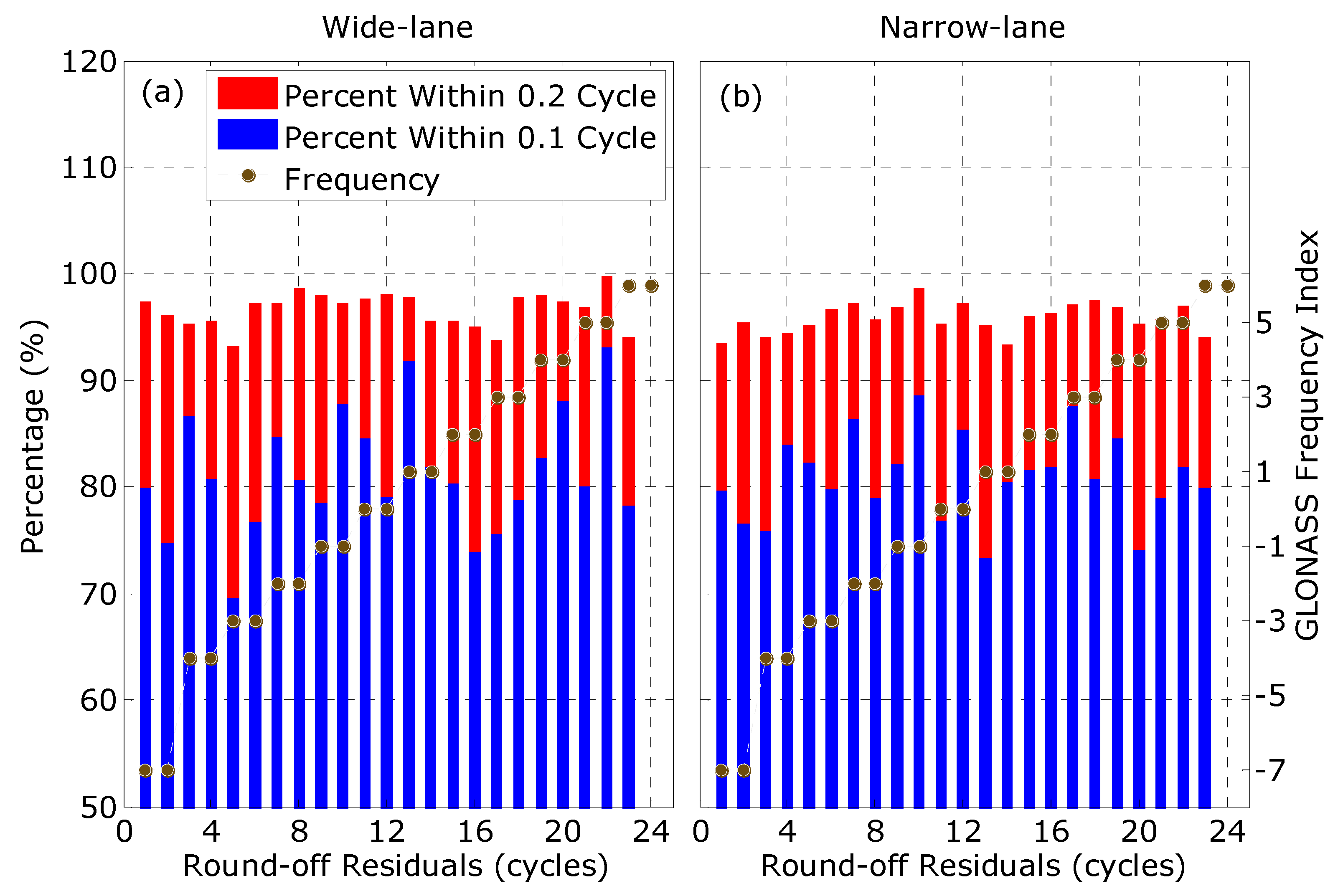
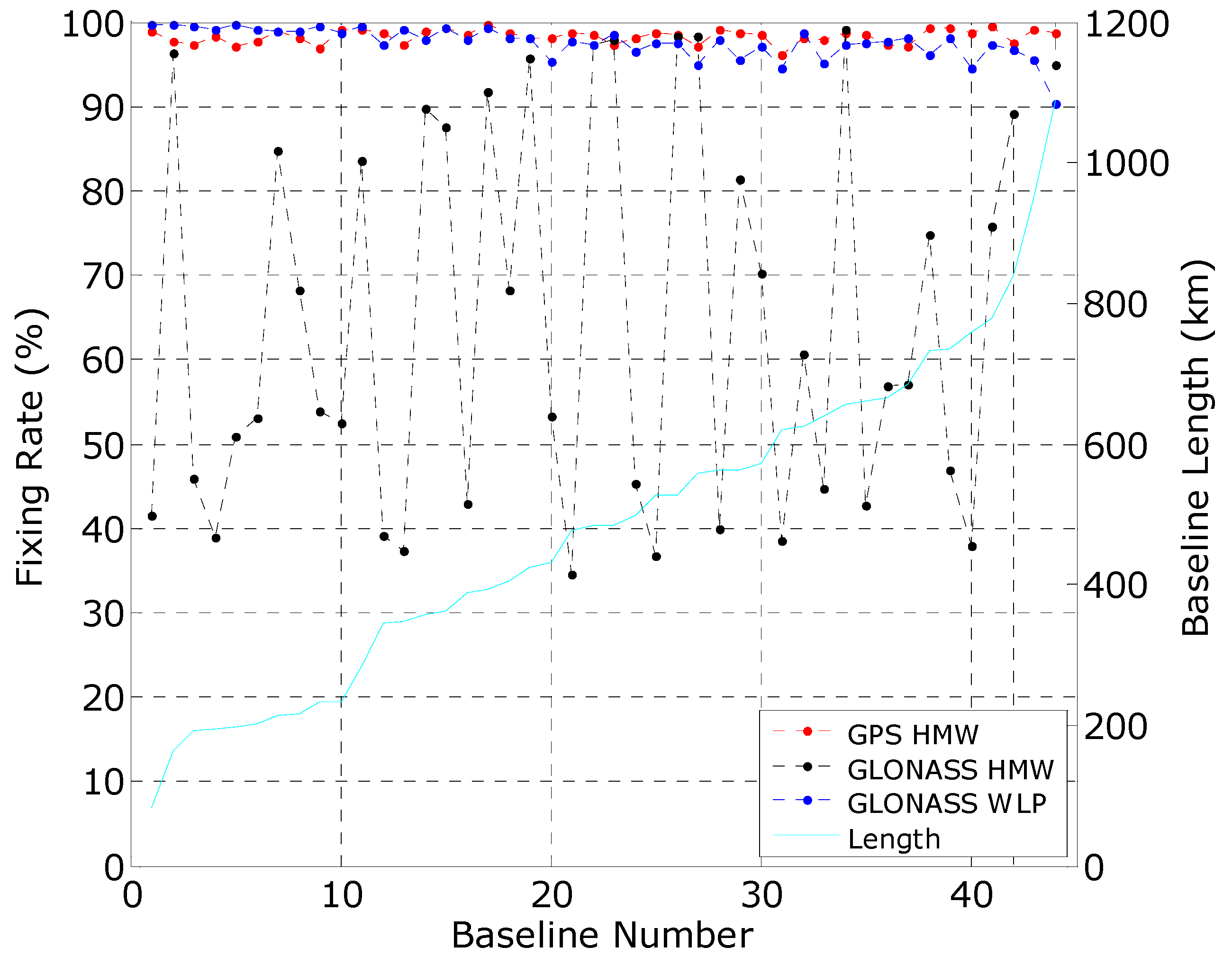
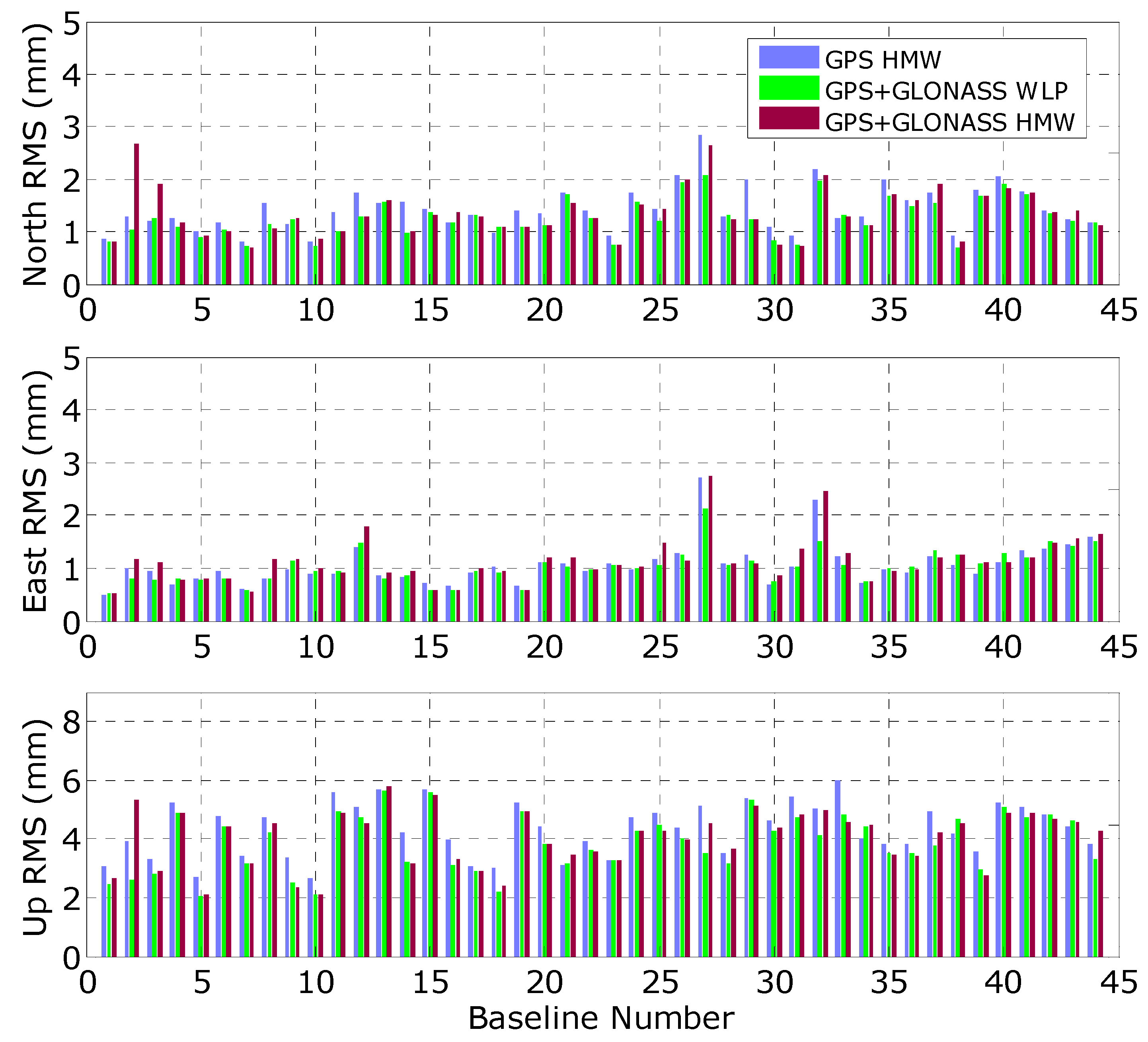
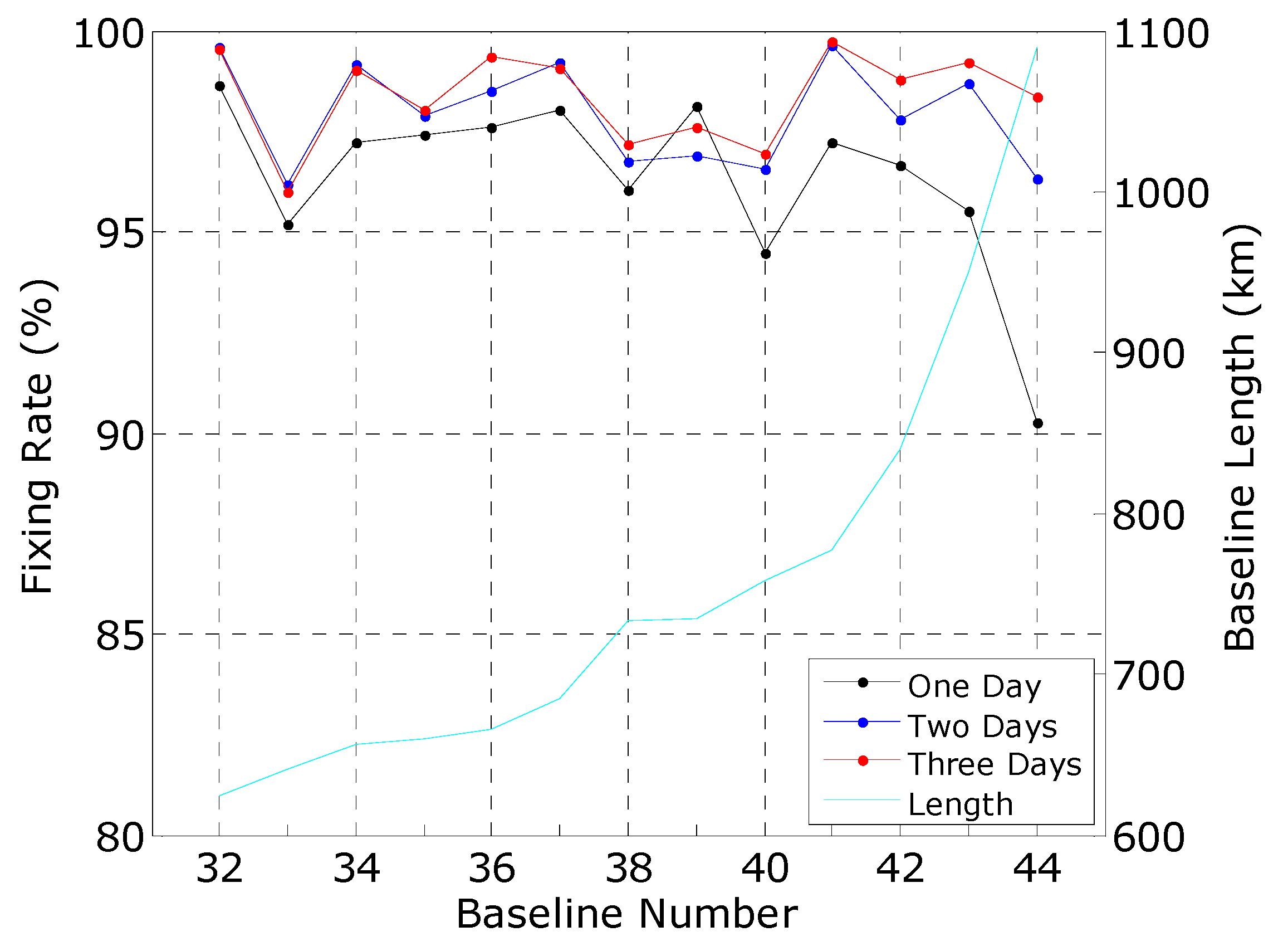
| Manufacturer | Receiver | Antenna | Dome | Firmware | Stations |
|---|---|---|---|---|---|
| Trimble | NETR5 | TRM55971.00 | NONE | 4.42 | CAEN |
| 4.48 | ENTZ PUYV | ||||
| TZGD | Nav 4.41/Boot 4.18 | BYDG | |||
| NETR9 | TRM57971.00 | NONE | 4.60 | ILDX | |
| Leica | GRX1200GGPRO | LEIAT504GG | LEIS | 8.10/3.019 | BUCU |
| NONE | 8.51/3.019 | VEN1 | |||
| GRX1200+GNSS | LEIAR25.R3 | LEIT | 8.51/6.110 | OROS | |
| LEIAR25.R4 | LEIT | 8.51/6.110 | TUBO | ||
| LEIAT504GG | LEIS | 8.10/4.007 | LAMA | ||
| LEICA GR25 | LEIAR25.R4 | LEIT | 2.62/6.112 | WROC | |
| Novatel | OEMV3 | NOV702GG | NONE | 3.701 | GLSV SMLA |
| 3.620 | KTVL | ||||
| TPS | NETG3 | TPSCR.G3 | TPSH | 3.4 | MSRT LBUG |
| JPS | LEGACY | LEIAR25.R3 | LEIT | 2.6.1 JAN,10,2008 | BORJ WARN |
| Septentrio | POLARX4TR | JAVRINGANT_DM | NONE | 2.3.4 | BRUX |
| POLARX3ETR | LEIAR25.R3 | NONE | 2.1 | HERS |
© 2018 by the authors. Licensee MDPI, Basel, Switzerland. This article is an open access article distributed under the terms and conditions of the Creative Commons Attribution (CC BY) license (http://creativecommons.org/licenses/by/4.0/).
Share and Cite
Zhu, J.; Liu, Y.; Wang, B.; Ye, S. Improved Method for GLONASS Long Baseline Ambiguity Resolution without Inter-Frequency Code Bias Calibration. Remote Sens. 2018, 10, 1223. https://0-doi-org.brum.beds.ac.uk/10.3390/rs10081223
Zhu J, Liu Y, Wang B, Ye S. Improved Method for GLONASS Long Baseline Ambiguity Resolution without Inter-Frequency Code Bias Calibration. Remote Sensing. 2018; 10(8):1223. https://0-doi-org.brum.beds.ac.uk/10.3390/rs10081223
Chicago/Turabian StyleZhu, Jiasong, Yanyan Liu, Bing Wang, and Shirong Ye. 2018. "Improved Method for GLONASS Long Baseline Ambiguity Resolution without Inter-Frequency Code Bias Calibration" Remote Sensing 10, no. 8: 1223. https://0-doi-org.brum.beds.ac.uk/10.3390/rs10081223



